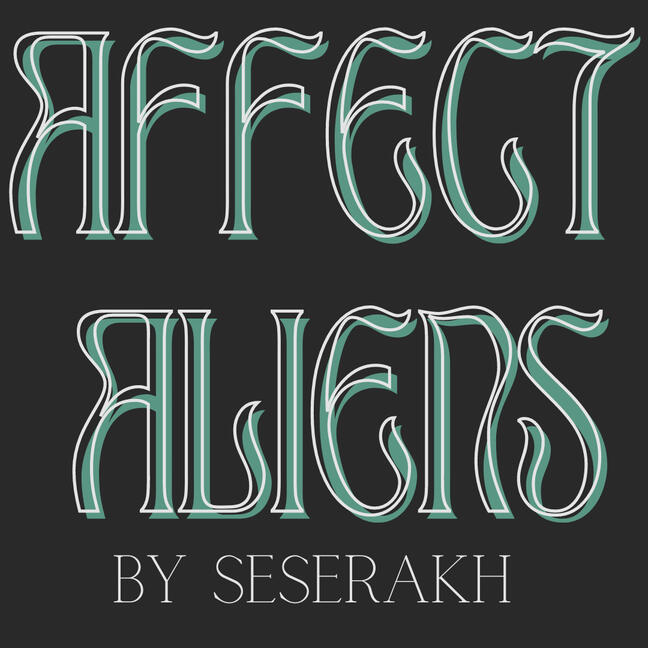



Collage Artist Anonymous
Photo's of Lorde Credit: (Top Right) Joan E. Biren, (Top Middle) Robert Giard, (Top Left) Joan E. Biron, (Middle) Susan Fleischmann, (Bottom) Robert Alexander




Art By: Mackenzie Reinhart



the holy right to bleed
by: jules
the body is a minefield
i have learned to escape
its slopes and hills and rivers
are a dangerous,
dangerous placethe body is a battleground
of all my hopes and dreams
nestled into anarchy
of the holy right to bleedthe body is a house
that i am learning how to keep
dusting, cleaning, loving
making it feel safemy body is a playground
of all the parts unseen
i let them go on dancing
despite the uncertainty
GOD IS NOT A HE
by: jules
Created in the image of–
The first human to see.
The great and mighty God
As transcendent as can be.Created in the image of–
The diverse well of being.
Neither this nor that nor
Anything.
Anything in between.
For it was all together
And together it would seam.Seamlessly together,
The ends could never meet.
For they were never ending,
The endings had not
Reaped.Created in the image of–
The human with no soul
For their seams were not apparent,
Until God said so.Created in the image of–
The human with two faces
The one with all the hair
And the other that never
Ages–Created in the image of–
The two were once one.
But God chose to split them up,
So they could forever
Love.Created in the image of–
Gender had no role.
In any of that human,
Or the merit of their soul.Created in the image of–
God was always they
But humans do such silly things,
Like making the almighty God
A being made of clay.

By: Mackenzie Reinhart

essays and longer words
Musings on Fatphobia: From a Fat Person.
by wander
As I sit in a cafe in Denver, Colorado writing about fatphobia in it’s history and the effects of it, I’m experiencing it. Not outright, no mean comments or cruel stares, but in the design of the furniture in the cafe.
Affect Aliens
by seserakh
To admit that we are Affect Aliens can be a grounded experience that reconnects our self with the fragmented parts of identities; it’s also a gateway for us to explore why we may find ourselves feeling/experiencing moments of detachment, sadness, discomfort, and rejection in a family or community setting.
The Genesis of Barbie
by jules
The cultural phenomenon of Barbie is unprecedented, yes. However, I didn’t really know how impactful this movie was going to be until I saw the absolutely unhinged video of a mega church pastor (and seemingly, grown man) beating down a Barbie Dreamhouse– with a Bible– strapped to a baseball bat.
the non-concept-ual whole
by civil anarchy
The concepts used in theory are crucial. Concepts provide a platform for connection as people share their experiences of suffering. Concepts also have the potential to limit the very connection they long to create.

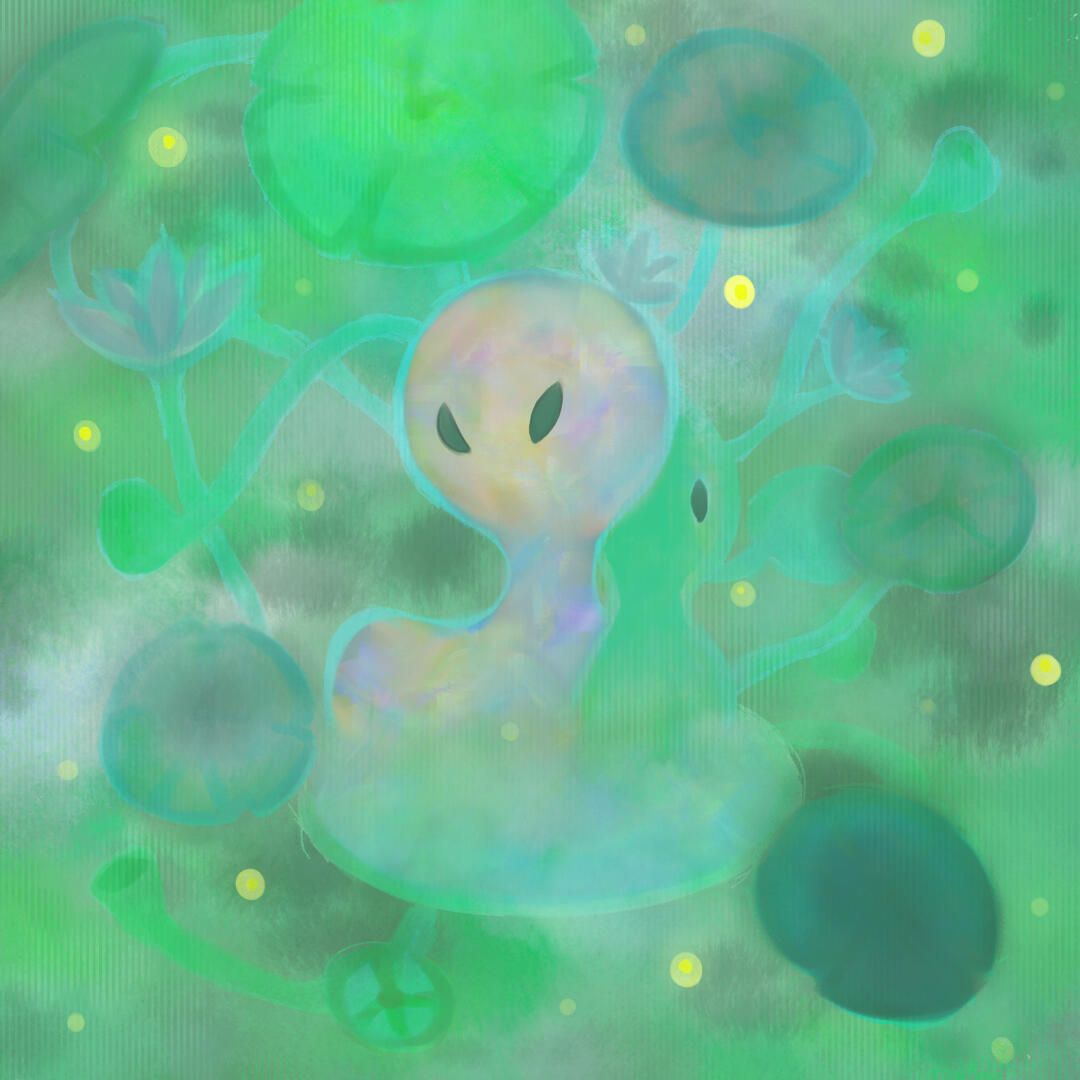
Art By: Seserakh

Art By: Seserakh

Digital Collage By: Jules
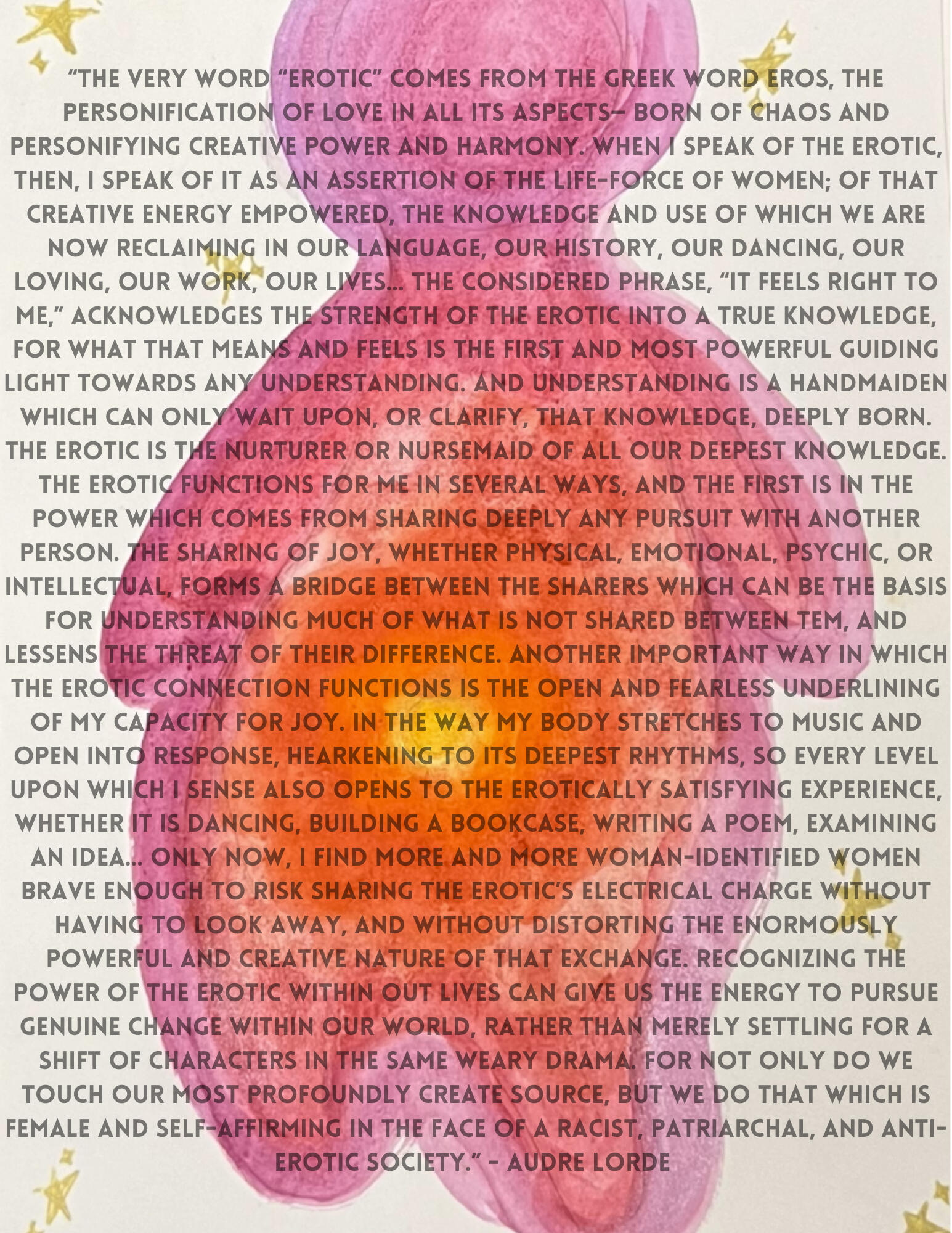
Art By: Wander, Words by: Audre Lorde

Art By: Seserakh

Art By: Seserakh




Artist Anonymous

by: zoe sears

by: zoe sears

by: Mackenzie Reinhart

by: zoe sears

Collage Artist Anonymous
Photo's of Lorde Credit: (Top Right) Joan E. Biren, (Top Middle) Robert Giard, (Top Left) Joan E. Biron, (Middle) Susan Fleischmann, (Bottom) Robert Alexander

Artist Anonymous


WHAT IN THE WORLD?: EXPLORATIONS OF CULTURE
The Genesis of Barbie: The Feminist Take We Didn’t Know We Needed: by jules
The cultural phenomenon of Barbie is unprecedented, yes. However, I didn’t really know how impactful this movie was going to be until I saw the absolutely unhinged video of a mega church pastor (and seemingly, grown man) beating down a Barbie Dreamhouse– with a Bible– strapped to a baseball bat.

art by: wander, words by: audre lorde

BY jules
Created in the image of–
The first human to see.
The great and mighty God
As transcendent as can be.Create in the image of–
The diverse well of being.
Neither this nor that nor
Anything.
Anything in between.
For it was all together
And together it would seam.Seamlessly together,
The ends could never meet.
For they were never ending,
The endings had not
Reaped.Created in the image of–
The human with no soul
For their seams were not apparent,
Until God said so.Created in the image of–
The human with two faces
The one with all the hair
And the other that never
Ages–Created in the image of–
The two were once one.
But God chose to split them up,
So they could forever
Love.Created in the image of–
Gender had no role.
In any of that human,
Or the merit of their soul.Created in the image of–
God was always they
But humans do such silly things,
Like making the almighty God
A being made of clay.

by: wander
As I sit in a cafe in Denver, Colorado writing about fatphobia in it’s history and the effects of it, I’m experiencing it. Not outright, no mean comments or cruel stares, but in the design of the furniture in the cafe.

Nurse rai: by erin doubenmier

Collage Artist Anonymous
Photo's of Lorde Credit: (Top Right) Joan E. Biren, (Top Middle) Robert Giard, (Top Left) Joan E. Biron, (Middle) Susan Fleischmann, (Bottom) Robert Alexander
A BODY OF OUR OWN: EXPLORATION OF INNER WORLDS

the holy right to bleed
by jules
the body is a minefield
i have learned to escape
its slopes and hills and rivers
are a dangerous,
dangerous placethe body is a battleground
of all my hopes and dreams
nestled into anarchy
of the holy right to bleedthe body is a house
that i am learning how to keep
dusting, cleaning, loving
making it feel safemy body is a playground
of all the parts unseen
i let them go on dancing
despite the uncertainty

Artist Anonymous

by: civil anarchy
The concepts used in theory are crucial. Concepts provide a platform for connection as people share their experiences of suffering. Concepts also have the potential to limit the very connection they long to create.

Artist Anonymous

artist: zoe sears

artist: zoe sears

ARTIST: Mackenzie Reinhart

artist: zoe sears

BY: JULES TIBBLES
ALERT! Barbie Movie Spoilers Ahead.

The cultural phenomenon of Barbie is unprecedented, yes. However, I didn’t really know how impactful this movie was going to be until I saw the absolutely unhinged video of a mega church pastor (and seemingly, grown man) beating down a Barbie Dreamhouse– with a Bible– strapped to a baseball bat.Naturally, I immediately bought a ticket to go see The Barbie Movie, and it was better than I could have ever possibly imagined.The irony of that pastor having a total tantrum about the movie being a supposed demonic force that makes people watch porn, (pretty weird to relate a childrens toy to porn, but that’s just my take…) is the many themes within Barbie that come from the very thing he used to beat down that house. The very thing he believes he is “protecting” by (literally) physically destroying it, to beat down something else, because… symbolism (major, major eye roll).Yep, you guessed it. I am talking about the Bible.The Barbie Movie, in shortThe Barbie Movie is a fantasy comedy film directed by Greta Gerwig, from a screenplay she wrote with her partner, Noah Baumbach. The story centers Barbie (Margot Robbie), Ken (Ryan Gosling), Gloria (America Farrerra) and her daughter Sasha (Ariana Greenblatt). Barbie has an existential crisis when she realizes she is malfunctioning (due to flat feet and cellulite..), and goes on a journey of self-discovery that takes Ken, Gloria, and Sasha on a journey of self discovery with her. It is hilarious, clever, insightful, fiercely feminist, and oh so good.
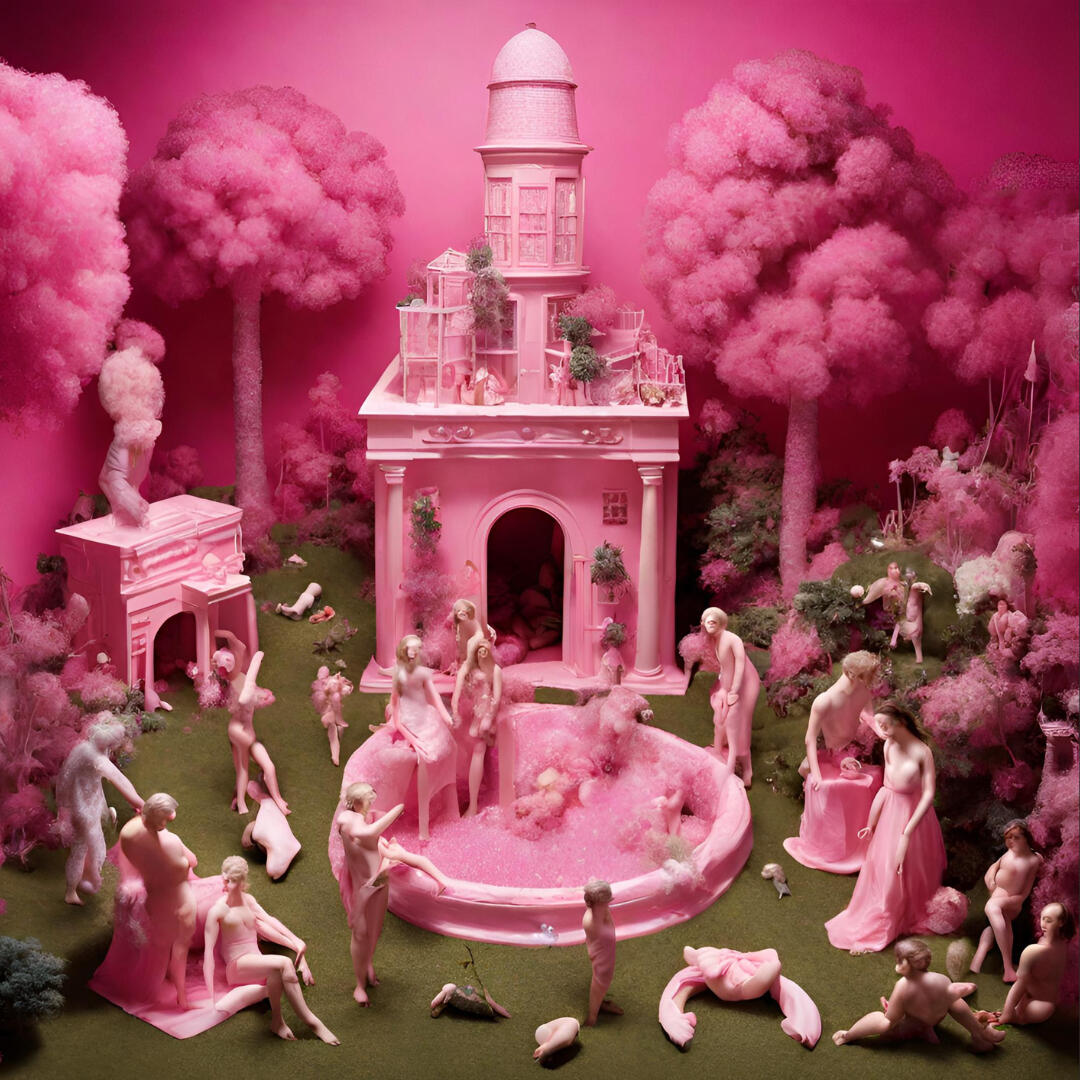
The Genesis of BarbieThe opening credits of Barbie begins with whirling sounds of wind, coinciding with a subtle hymn, that sounds something similar to the beginning of every song. With it’s black screen and irky humming, it gives a feeling of darkness, emptiness, and what one could imagine lays at the bare bones of existence.Various signs of life begin to emerge; the sun is rising, the birds are chirping, and the songs of crickets and grasshoppers are emanating in the background. Narrator Helen Mirren breaks the silence by saying, “since the beginning of time…” and continues with, “since the first little girl ever existed– there have been dolls.”The scene is almost other-wordly, in a mars like environment. Rocky and green-less, with little to nothing in sight, are little girls playing with baby dolls. The little girls, though toddlers, are almost dressed as what one would imagine a young mother in the 18th century would dress like. Also Sprach Zarathustra begins to play as a huge figure appears– and suddenly– a giant God-like Barbie doll is standing before them. In awe, they realize there is more to dolls that babies, and there is more to girlhood than training to be a mother.As the music rises to the point of climax, one of the little girls takes the baby doll she was once cradling, raises it high above her head, and violently smashes her tea set. All the other girls join in with her, and Barbie smiles, putting her glasses back on.The next scene begins with Mirren saying, “Barbie changed everything. Then, she changed it all again. All of these women are Barbie, and Barbie is, all of these women.” Barbie from all different eras, shapes, sizes, and ethnicities begin to show up on screen, and we are being told the story of how Barbie changed the face of womanhood forever.2001, Barbie, & GodThe infamous scene in 2001: a Space Odyssey is clearly the inspiration for the opening scene of The Barbie Movie, which is an incredibly interesting choice. As so much of what 2001 was doing was challenging the supposed paradox of religion and science, and juxtaposing faith and evolution. It had very clear influences of the beginnings of Genesis entangled within those first few scenes, taking influence from the first two lines of the Bible.Genesis 1:1-1:2;“In the beginning God created the Heavens and the earth. The earth was without form and void; and darkness was on the face of the deep. And the Spirit of God was hovering over the face of the waters.”Does that sound familiar? This ‘beginningness’ in what seems like an empty, formless void– and a humming of life looming overhead, waiting to be seen. Mirren’s words at the beginning of Barbie were also a very specific choice; with “since the beginning of time…” being the very first line of the movie. An almost creation story of feminism within the Barbie world, is tied to the creation story of all being.

BarbieLandEarly on in the film we learn that the Barbies think they have solved all issues of girlhood and womanhood, because they live in a perfect world created just for them: Barbie Land.In Barbie Land, everything is built for Barbie. There are no bad hair days, no morning breath, no expired milk, and each day is perfect and flawless and pristine. Barbie wakes up, floats out of her dreamhouse, and drives wherever she pleases and is met with love and adoration everywhere she goes.Until one day, as she is dancing with all of her friends at the millionth party they have ever had– having the time of their lives– Barbie blurts out words that none of them have ever heard before;“Do you guys ever think about dying?”The music irks, everything stops, and nobody knows what to do or how to respond to this obviously offensive act of contemplation. Barbie immediately becomes embarrassed, and turns it around by saying, “I mean, I’m dying to dance!” Everybody squeals in laughter, and the party continues.But the party doesn’t continue for Barbie, as when she wakes up the next day, everything is different. She is clearly groggy and tired, her shower was cold, and she eventually comes to find out, of all things, that her feet have become flat.Barbie is mortified, and shares her embarrassment with her Barbie friends. One of them says “Barbie doesn’t get embarrassed!” Then after realizing the seriousness of her predicament, she is sent to “weird barbie” to address her “malfunctions” which are her flat feet, cellulite, and bad breath.Is BarbieLand... Eden?When we look at this closer, we can see that Barbie Land has very similar attributes as the Garden of Eden.In Eden, everything is perfect. Adam and Eve have not yet had the “knowledge of good and evil,” as they are in what one can only imagine as the primordial union. They are given all the fruits and plants they could ever want, with a garden all their own, in Eden– which in Hebrew– is sometimes translated to pleasure. Until one day their perfection is broken, when Eve eats the fruit from the tree of knowledge and gives it to Adam to eat, too. Suddenly they are ashamed of their nakedness, something that God is confused by as he comes walking back into the Garden.Similar to the “Barbie doesn’t get embarrassed!” Adam and Eve hide themselves when they realize they are naked, and they hear God walking towards them. God asks, “Who told you you were naked?” and he realizes that they did exactly what they were told not to do. They gained the knowledge.The Knowledge of Good & EvilThough Barbie never eats from a tree and suddenly gains sentience, she does begin to experience very human experiences. Almost as if she had become mortal over night, breaking the assumed “primordial union” of her creation into Barbie Land. Her initial thought of death is what begins this cycle of imperfection– and it was then that she realizes that everything is in fact, not perfect. She gains the knowledge of good and evil, of perfection and imperfection. As she realizes this, her outer world begins to manifest this imperfection, and so begins her very human existential crisis that leads her to the real world.But What About Ken?Ah, Ken.Ryan Golsing plays the side kick we have come to know fondly as Ken, in the most clever and hilarious and perfect way. Our introduction to him in the film is, “Barbie has a great day everyday, but Ken only has a great day if Barbie looks at him.” It is followed by Kens hilarious attempt to get Barbies attention by surfing into the waves, that we soon realize are solid and likely plastic. He flys up into the sky and comes crashing down to earth, and all the other Kens laugh as Barbie goes to make sure he is okay.The hilarity of Ken is not that he is desperate for Barbies attention, but that in real life Mattel made him as a mere accessory to Barbie– and the movie plays on that fact so well. In a world where patriarchy is the dominant occurrence in our culture, seeing this shift of perspective is stark and also so well written into the story line of Barbie. As in Barbie Land, everything is flipped, and the Kens are there as the “second ones” to the Barbies.Genesis 2:21-23 (King James translation) says;“And the Lord God caused a deep sleep to fall on Adam, and he slept; and He took one of his ribs and closed up the flesh in its place. Then the rib which the Lord God had taken from man He made into a woman, and He brought her to the man. And Adam said: ‘This is now bone of my bones, and flesh of my flesh; She shall be called Woman, Because she was taken out of Man.’”Now, even if you haven’t heard this specific passage, chances are you are familiar with this story and it’s effect on modern culture. The hilarity (and cleverness) of Barbie, is that it obviously flips this narrative, in a ridiculous-fantasy-themed creation. Where Ken was made for Barbie, rather than woman being created for man.

& Last but Not Least, Ruth Handler.If I tried to write down all of the pieces that I saw in the Barbie movie that could be related to the Bible, we would be here for a long time. So I’ll end with this last piece, which feels important and very specific.When Barbie is running from the men of Matell after they tried to trap her inside of a box, she finds herself in this long, empty hallway of doors. She opens one of them, and finds herself in an older womans kitchen, who invites her in for tea.In this short and necessary scene, the woman gives a sort of sweet and wise old woman vibe– and helps Barbie escape the men of Mattel. Barbie asks who she is, but before she gets an answer, has to rush and leave to escape. We find out later when they meet again that the woman is Ruth Handler, the creator of Barbie.The movie comes to a close with Ruth saying: “That’s the whole point, I created you so you wouldn’t have an ending.” Then, “Come, walk with me.”They are suddenly surrounded by a white, heaven-like aura. Barbie begins to share her experience with her creator, and Ruth gives Barbie insight as to what being human is really like. Barbie asks permission to be human, saying, “you are my creator, don’t you control me?”Ruth giggles, saying “I can’t control you more than I can control my own daughter.” (Who she was named after). Then Barbie realizes, “So, being human is not something I have to ask for, or even want, it’s just something that I discover that I am?”They both realize the sanctity of this moment, and hold hands. Similar to the famous Sistine Chapel piece, The Creation of Adam, where Michelangelo depictured God and Adam’s hands touching– Barbie and Ruth embody the essence of creator and created.Ruth shows Barbie what being human is really like, in all it’s pain and beauty and heavenly suffering, and Barbie feels, for real, for what seems like the very first time.
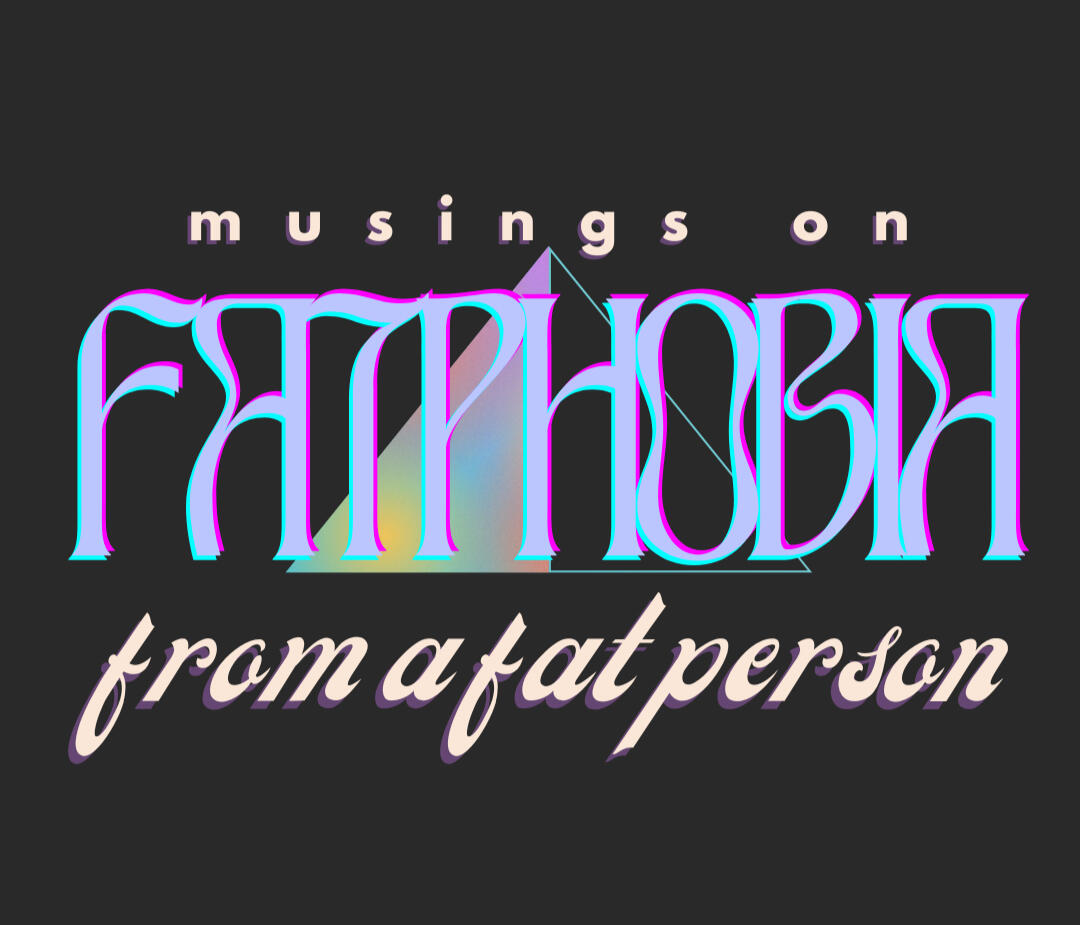
BY: WANDER
Introduction: What is Fatphobia?Fatphobia can be hard to define, because it can cover so many different aspects of hatred or insecurity, but I personally think that Virgie Tovar sums it up well in her book and self-described manifesto, You Have the Right to Remain Fat. She says, “Fatphobia is a form of bigotry that positions fat people as inferior and as objects of hatred and derision. Fatphobia targets and scapegoats fat people, but it ends up harming all people... Fatphobia creates an environment of hostility toward large-bodied people... and places the burden of anti-fat bias on “non-compliant” individuals— that is, fat people” (pg. 16-17).The non-compliance that Tovar mentions here is specifically related to diet-culture, as that is a large focus of her writing. I think that the emphasis of hatred, harm, and scapegoat-ing are all really important to how we can see fatphobia clearly in the world. The most obvious form of fatphobia is the hatred— stares, cruel comments, questions about weight loss and health, self-deprecating comments relating to body size, et cetera. That hatred obviously harms fat people, but that hatred also creates things like biased sizing for clothes, sizing for furniture, advertisements, and things like diet culture, which can be harmful to everyone and often are. Because of both of these things, we can often see fat people being used as scapegoats for various other issues, but especially food and exercise, where people will weaponize fatness against fat people and themselves and blame it all on fatness.Fatphobia is deeply engrained in our society, and ends up being wielded as a weapon against everyone, not just fat people.
History of Fatphobia: Sabrina StringsIt is also important to recognize that fatphobia, like a lot of the phobias and isms that we are surrounded by is an intersectional issue.
Sabrina Strings is the author of Fearing the Black Body: The Racial Origins of Fat Phobia. In an interview with NPR, she describes how a lot of the fatphobia we’re used to comes from racism and specifically surrounding the Transatlantic slave trade. Strings talks about some of the research she did for her book, starting with French philosophers and colonizers, “... Africans are sensuous. They love sex and they love food, And for this reason, they tend to be too fat. Europeans, we have rational self-control. This is what makes us the premier race of the world. So in terms of body size, we should be slender, and we should watch what we eat”. Strings goes one to talk about how in addition to the creation of the idea of race within skin color being used as a differential between slaves and slave owners/non-slaves, body size became part of this.Strings also describes the ways that the BMI scale is racist, fatphobic, and sort of nonsensical by telling her interviewer and the listener about how the BMI only figures height to weight ratio which ignores, “...bone density, muscularity, any other type of genetic influences in your weight.” (I want to add in addition to the genetic influences it doesn’t figure in any other health concerns like hormonal imbalances or things like that as well). Creating this system to be inherently flawed leads to anti-fat and racist biases in the medical field which constantly leads to fat people and people of color being harmed in spaces that are supposed to help them. So, not only is fatphobia harmful to everyone now, but it comes from racist ideologies coming from colonization and the various slave trades across the world. Because of how entrenched it is in our society, sometimes it can go unnoticed in smaller examples or completely ignored by those who don’t care to learn.Musings: As I WriteAs I sit in a cafe in Denver, Colorado writing about fatphobia in it’s history and the effects of it, I’m experiencing it. Not outright, no mean comments or cruel stares, but in the design of the furniture in the cafe. The cafe is very open, with a few booths lining two of the walls and then tables and chairs fill the rest of the space. The chairs in question are all identical— silver metal, a backrest that comes down into a rounded metal pole that I guess someone could call an armrest.As I look around the cafe, not one person seems to be using it as an armrest, but no one seems to be particularly bothered by them. The only exception I can see are me, and an older fat couple who gave up their seat at a booth so that a family could sit there. These armrests are digging into my thighs, and I’m sure if I were wearing shorts there would be marks indented into my legs from the pressure.Even if it wasn’t purposeful, the design of these chairs is fatphobic, it is exclusionary of or harmful to fat people who just need a place to sit at a cafe. There is something sort of funny to me about the fact that for people unaffected by fatphobia, they can’t see it. There are so many restaurants where the only options to sit are chairs like these. Chairs that squeeze me so tight that’s all I can focus on tend to make going-out experiences less enjoyable, believe it or not. Since I started writing this paragraph, a booth opened up, and I moved out of the metal chair, but I can still feel where the chair was digging into my thighs. I don’t think that the cafe, or any establishment for that matter, uses these metal chairs because they’re fatphobic, but because they simply don’t think about it. There is so little thought put into the comfortability of fat people within environments like these.Fatphobia is so built into our society, that there isn’t even a second thought to things like the metal chairs. While I’m on the topic of chairs, specifically, I want to point out that even on Naropa’s campus we have this problem. In some of the classrooms in the Sycamore building, there are the chairs that have the fold down desk/armrest situation attached to them. Those chairs not only have normal armrests (although they’re not nearly as tight as the chairs in this cafe), but the desk attachment consistently squishes my stomach to the point of being uncomfortable. It’s already frustrating to have these chairs exist in spaces like restaurants or waiting rooms, but to have the same experiences in a learning environment that is supposed to be conducive to learning, is incredibly distracting and annoying. I do think that in the nature of intersectional theory, it’s important to point something out. That thing being that chairs with armrests aren’t inherently bad or fatphobic, and for a number of people, armrests can be really helpful for mobility in terms of getting up and down. There are many disabled and elderly people for which getting up and down unsupported is really difficult, so the arms of chairs can be crucial in terms of assistance for them. This to say that the solution to the fatphobic design of the chairs is not always to just remove the armrests. There are also chairs with armrests that are wide enough to fit fat bodies without pain. The problem here isn’t automatically armrests, but the fact that there is so little thought towards fat people’s existence that this type of furnishing and architecture is everywhere. There is also an intersection between fatphobic architecture and anti-homeless architecture that benefits no one except for the people in power who refuse to see anyone outside of their ‘normal’ as human beings.

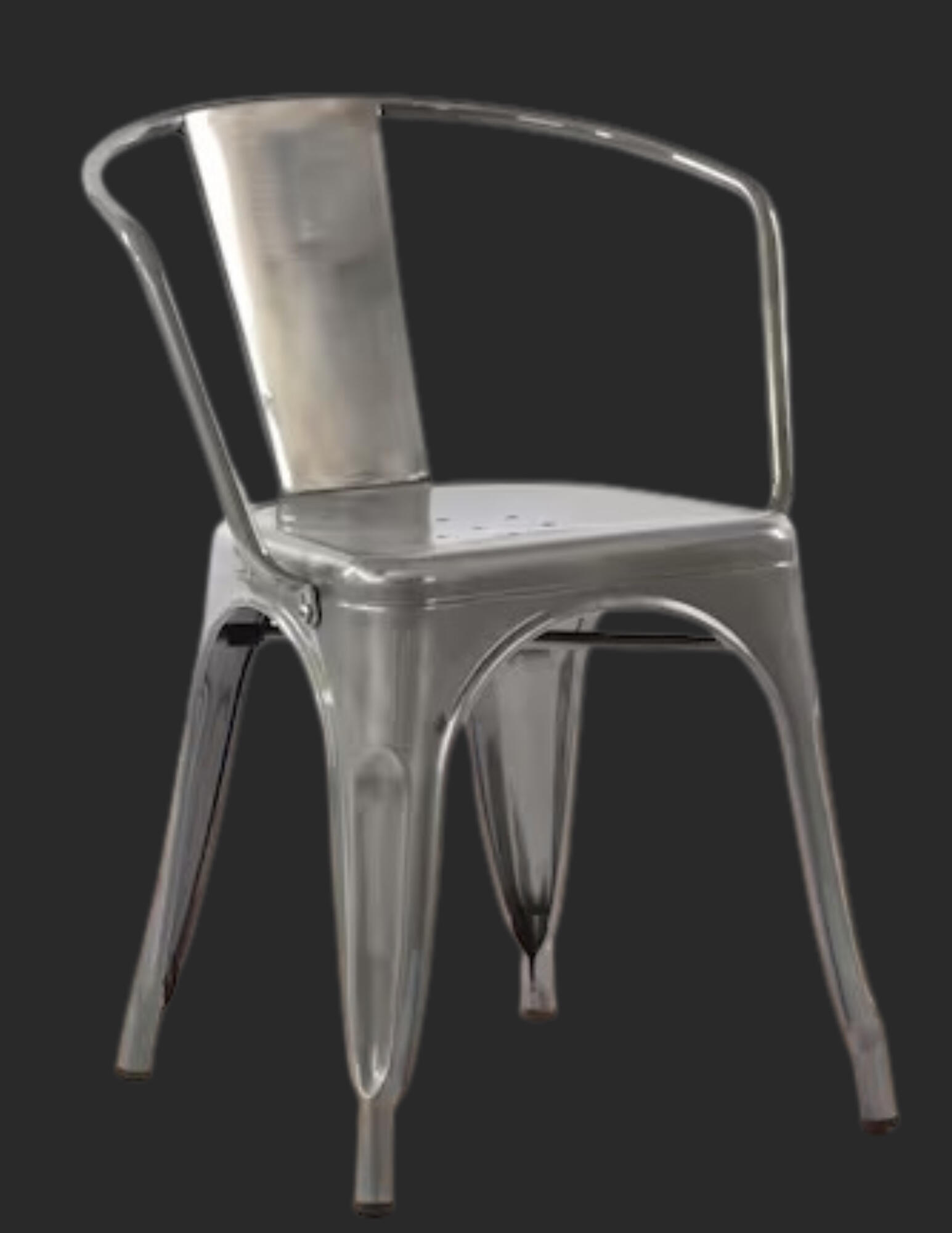
ResistanceThere is this thing that happens when people either don’t understand, don’t like, or fear the unknown experiences around them and people who live those experiences, where that confusion, dislike, and fear can lead to dehumanization. If someone exists outside of the norm, if they behave differently or look different, then there is logic for some people to stop seeing them as human. We see this a lot with white supremacy ideology and colonialism. Dehumanization can be used by these ideologies and systems to make it seem like they aren’t actually cruel because in their minds, the people they’re harming aren’t actually people. As Sabrina Strings talked about, a huge part of fatphobia are its origins in racism where it was used to quite literally separate slaves, and non-slaves. Slavery is one of the easiest named forms of dehumanization for us to see and recognize. In the US at this point, dehumanization can be harder to see sometimes. Within the US, anyone who isn’t a cisgender, heterosexual, upper-class, white man is at an ever constant risk of being dehumanized at every turn. This only gets worse the more aspects of one’s identity intersect with pieces that the colonial-patriarchal system has deemed to be “bad”. As we live in a society where physical aspects of one’s identity can be used against them by oppressive systems, then the simple act of existing in those bodies is an act of resistance. There is so much pressure to change when you live in a hated body, and the act of not changing, of staying true to who you are, is resistance. As a fat person for example, not listening to the toxicity of diet culture is resistance. As a queer person, being loudly out and proud is an act of resistance. When the system is telling us to conform and change in order to fit within it, we can resist that simply by existing as we are. Existing in oppressed bodies is an act of resistance against that oppression.

Artist Anonymous









In Vanita Reddy’s essay “Family Togetherness, Affect Aliens, and the Ugly Feelings of Being Included,” she introduced the term Affect Aliens as a group of people who are unwilling to experience a specific set of joy that only serves those whose identities can be assimilated into the discipline of family togetherness. This sense of family togetherness revolves around a type of love that is based upon the irresolute and aggressive heteronormative nature which excludes anyone who “fall outside normative economies of love and attachment.” In most circumstances, gender binary disciplines and the roles of femininity and masculinity form the sexual respectability discipline that manage and dictate the occasions of family togetherness. Affect Aliens are usually the people who occupy one or multiple excluded political identities (e.g, being transgender, single, or divorced), and they are prone to encounter negative emotions that register social powerlessness, envy, irritation, and anxiety that one holds and experiences as an unaccepted individual. The expectations and attachments we give upon our family can reinforce such negative emotions.For me, I find myself being an Affect Alien on my mother’s side of the family (my grandparents, their children, and the grandchildren) in a way that there’s only a loose connection between and lack of deep love and caring for each individual, and there’s no doubt that the familial dynamic falls under the heteronormative and patriarchal economy of love. I also find this part of identity applicable to many different contexts, such as being an Affect Alien to my Chinese heritage in a way that I don’t feel completely blend in or fit into this one specific culture. Part of the reason why is because I was raised in an atypical middle class Chinese family and my parents adopted a free-style education method to let me try and learn new things freely. I developed my own system of thinking (non-dual and non-binary thinking) and perspectives on life without being heavily influenced by any framed aspect. The experience of studying abroad in New Zealand at fourteen was another factor that drew me apart from my loose attachment to my Chinese identity, and I gradually developed this thinking that I am a citizen of the universe. The labels of race, ethnicity, gender, class, sexual identity and so on should not be boundaries and limits that we give to ourselves to further emphasize on the disintegration, separation, and division between people. After all, we are the same embodiments of love that came to this earth to experience life in different containers.I want to extend the concept of the term Affect Aliens into a more inclusive notion that incorporates everyone who experience feelings of being excluded in their families and communities and willing to be a part of it because we are all Affect Aliens to something to a different extent in our societies or cultures, specifically in the context of living out of sync and pace of this toxic set of societal norms and justices.Realizing the part that makes us hurt or devastated serves as a great opportunity to heal. In the reading “Decolonizing Religion, Transforming Spirit: The Imaginal in Gloria Anzaldua’s Autohistoria-Teoria” by AnaLouise Keathing & Kakali Bhattacharya, the author introduced a method called “autohistoria-teoría” that’s used to interrupt the behavioral patterns that internalize and reinforce the oppressive societal labels. These fragmentations provoke multiple layers/aspects (e.g., familial, emotional, spiritual, etc.) of forms of exile and imprint their dualistic narratives in our consciousness so that we will carry these fragmentations in our ways of being. These fragments can be retrieved through enacting the Coyolxauhqui imperative, which is a term for an ongoing and healing process of disintegrating and reintegrating the internal fragmentations, and reconstructing and reframing self-identity and insights. To admit that we are Affect Aliens can be a grounded experience that reconnects our self with the fragmented parts of identities; it’s also a gateway for us to explore why we may find ourselves feeling/experiencing moments of detachment, sadness, discomfort, and rejection in a family or community setting.
In my project, I want to incorporate the idea of using Affect Aliens as a term for healing, disintegration, and reintegration process. I used arts-based research and created a storyline for each digital drawing, and there are four artworks in total (the name of each artwork is in the bracket):
1. (Haze) - Confusions of the self, who am I. The ghost is looking down, pondering upon the concept of the self while comparing with others. It’s searching for a root, a grounded place and being.
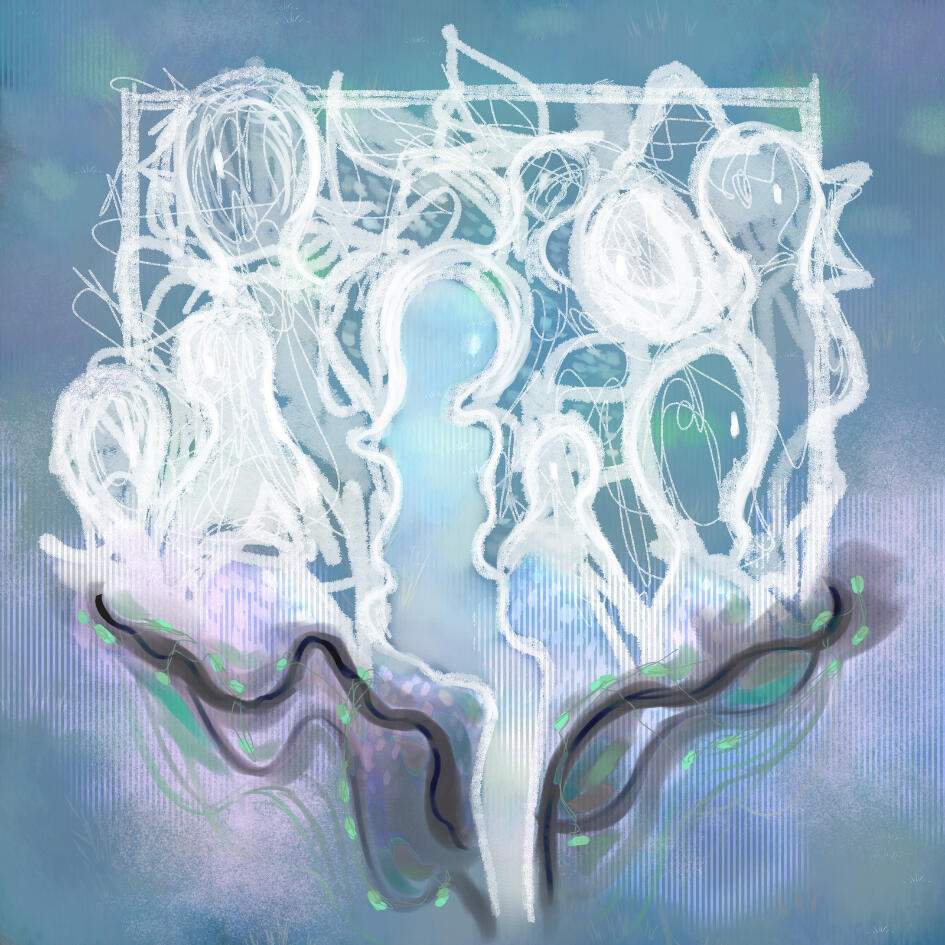
2. (混沌) - The title means chaos. It’s presented as layers of threads of thoughts, with ambiguity and negative thoughts/beliefs. The dark and contrasting colors are used to present the unease, anger, pain, suffering, deep sadness, and all ugly or negative feelings that one experiences when they fall into the belief of being an outsider and the rejected.

3. (Bloom) - The ghost is situated in a lotus pond and surrounded by lotus and lotus leaves. The lotus is cleansing and grounded that’s often used as a symbol of awakening and enlightenment in Buddhism. This part depicts the liberation, reintegration, and self-transformation process.
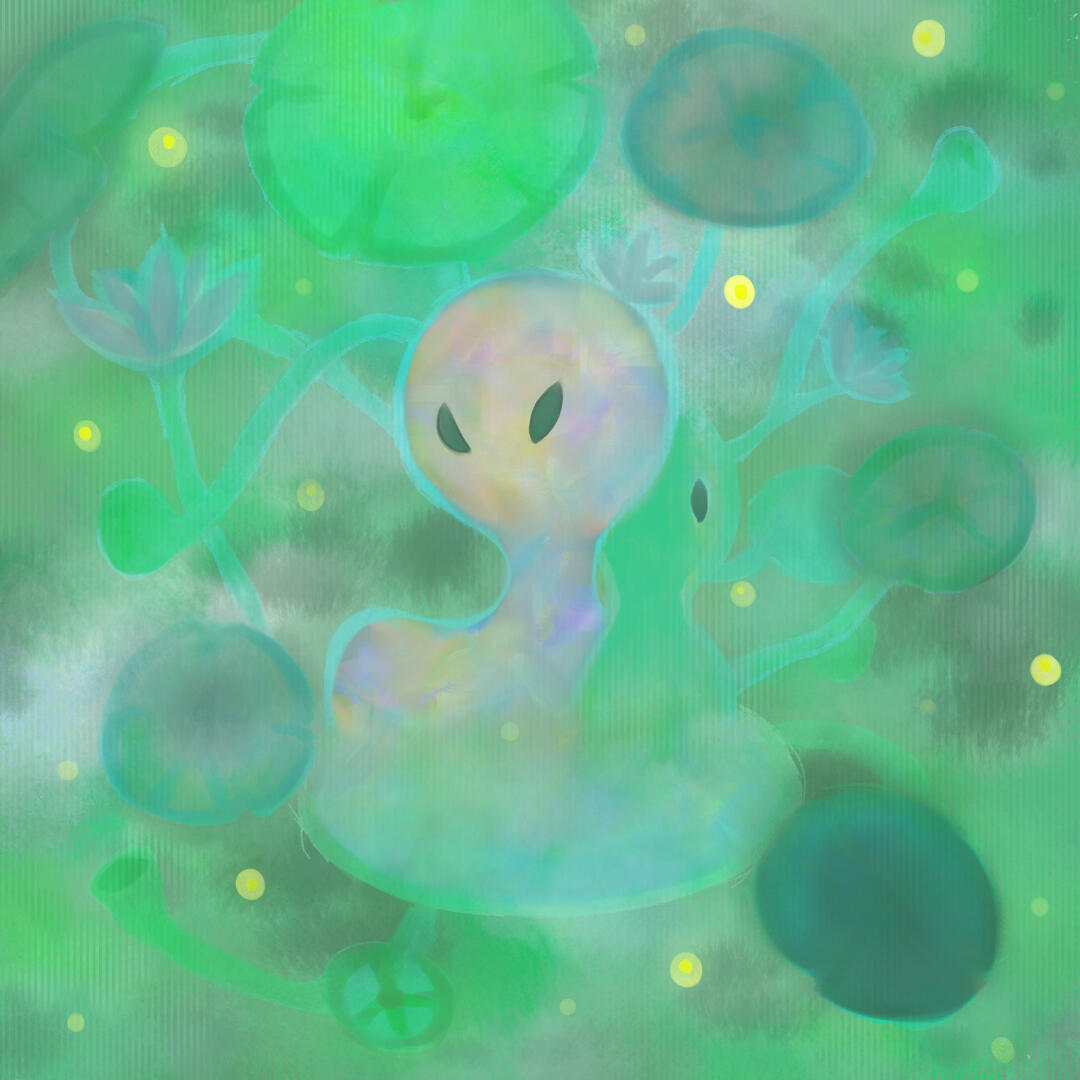
4. (Midori) - The title means green. It presents the inner peace, moving beyond the self, connection, togetherness, loving kindness as a whole.

I used the colors as a central approach to depict different emotions and feelings, and the ghost-like figure can be referred to the viewers (Affect Aliens). The varied green is present in all four drawings because it’s my favorite color and it represents the uninterrupted flow of life force/energy in all of us. The aim of these four consecutive drawings is to take people on a journey of self-exploration, to sync with the colors and feel yourselves being healed from interacting with them both consciously and subconsciously. It’s an experiment that can’t be complete without the viewers’ cooperation.
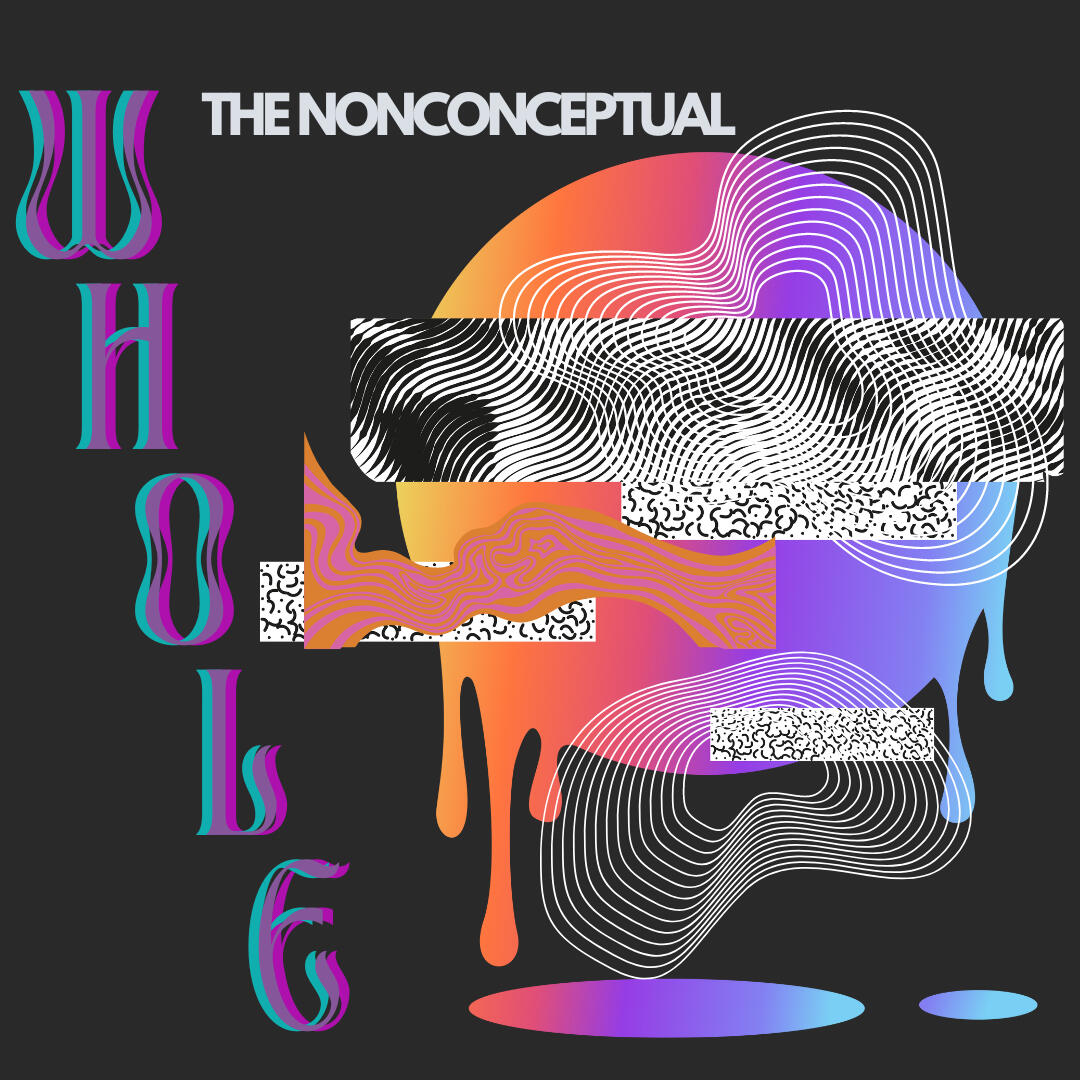
by civil anarchy
Artist’s Statement:My time in queer feminist theory has been charged with laughter, confusion, contentment, and curiosity. Queer feminist theory, though liberatory, has at times elicited feelings of trapt-ness within me. I longed for a way to embody what queer feminist theory meant to me. The concepts used in theory are crucial. Concepts provide a platform for connection as people share their experiences of suffering. Concepts also have the potential to limit the very connection they long to create.That is why I offer, here, a six-piece series that I hope reflects intersectionality, through nonconceptual writing about the parts that make us whole. I hope these pieces provide for you, the space to laugh, be, and question what queer feminism means to you.What is a woman?Take a journey with me through the nonconceptual whole.A whole you say. But what are its parts? Can you have a whole without its parts, parts without a whole?A sensorium of parts creates the whole.Visual - Auditory - Gustatory -
Olfactory - Tactile - Proprioceptive
Visual:
Sealed, stagnant
On this wall now
Like a doll in a frame
Wisps, black wisps
Muted, meshed lighting
Next to sand-like wax
A pine cone stands
Vanquished curiosity, cellulose
Two levels
Hearth greets the tile
Seven melted attempts at warmth
Pathos, ivy, driftwood from the Outstretched and wrapped in white hairs Reach for the hometown
Dry bubbles - handless
Rounded and worn
Tiered neck arriving
Resting in their vessel
bound
fight
Pilled linen
Auditory:
Fffffffff, splashhhh, crunch, crunch, crunch. Scraping over firm disconnection. Continuous scrapping. Scrape, scrape, scrape. Voices muffled, but concise. Plop! A condensed and elongated crunnchhhh. —-------------------------------------------------------------------- -------------------. Skcrunnnch, ppffftttt, skrunch. —--------- Hollow cylinders, kilnk, klink. Their connection bright and warm. —-----------------------------------------------------. Simultaneously low and high, multiple voices meet. Only a second of cawing in the distance. Beep. splashh, beep. Bong , bing, bong - bong. Rhythmically dancing bronze. Out of tune, but timely. Now ended. —------- Harder to hear the distinction between noises now. Vveeeeehhh. Bump, scrape. More scrapping, scrapping, scrapping of disconnection. —-------- Squeeeekkkk, squeak, creaaakk. Now a constant, low humming surrounding. Rufff, ruff, “HEY!” “no!.” waahh wahh, “I know.” Voices are closer, easier to make out. More voices, more sounds, harder once again to separate. Vrmmm. Can no longer hear the once constant, low humming. Splash! Eeehhh. —---------------- The constant low humming was able to return. Sharp and abrupt movement hitting the disconnection. Now, a hollow rattling, getting louder and louder. Same condensed and elongated crunch. —----------------- ruff, ruff, crunchhhhh.
Gustatory:
Nurturing
Remanence
Indulge
Melting
Forgot to
Want more
New combinations
Struggle to taste
Living activity
Smokey oil invokes gathering Meals and memories
Fragrance Comfort Opinions
of yesterday savor
Olfactory:
Cinnamon , ginger, clove. Peppercorn? The clove and cayenne are sharp like vinegar. Hints of coconut greet my hairs and travel past, creating a little movie in my brain. The time I received the coconut bowls. They were a wonderful gift. Then came my smoothie phase, everyday, with homemade granola on the stoop of apartment number 3. I sneeze and the movie dissolves. I still feel the warmth of the sun from the stoop on my skin. Warm like a windchime. My nose is in the mug now, attempting to take it all in. Around my face as I exhale, steam. Steam that slowly takes the shape of the mug around my face, like the hemline of a skirt. Are my perceptions distorted now? An olfactory overload. I try again. Back in the mug.
Tactile:
Right heel, then ball. Left heel, then ball. Repeating.
The curvature of each foot maneuvers the unevenness - toes grasping. Right heel, then ball. Left heel, then ball. Repeating.
Each exposed part, renewed from the speed through which it’s existing.
Right heel, then ball. Left heel, then ball. Repeating.
Life-giving expansion causes tightness at the midline.
The unevenness revisited. What feels like an injection of vital fluids smacks against my calf, the moisture dripping from the hairs. Right, heel, then ball. Left, heel then ball. Repeating.
Exiting my nose is more moisture, tickling as it trickles.
The smooth cloth that covers my fingers provides relief.
Right heel, then ball. Left heel, then ball. Repeating.
Right heel, then ball, toes grasping. Left heel, ball and toes hover. Tightness in my lower back, arms extend, shoulders tense.
I’m moving without moving from a patch unmelted in the shade.
Right heel, then ball. Left heel, then ball. Again able to repeat. Cool air enters the area of my eyes as I turn my neck.
Thighs jiggle and harden with each step. Right heel, then ball.
Proprioceptive:
Am I perfect yet? It’s always a struggle. My movements are so exquisitely precise and delicate, that even I sometimes believe them. I feel the space my body takes up, or lack of, and I relish in that. So deep in my thoughts. Is this really what I’m experiencing? I detect other bodies near me, an arm’s length away. I straighten my back, lower my shoulders and clench my jaw. I just do it. So deeply ingrained. Forces of pressure surround my muscles from yesterday’s run. I love her, the runner. Life’s answers permeate her body limb to limb. She smiles knowing it’s always ok.Are there two of me navigating these responsibilities of life? Am I active or am I passive?
Passivity is being/ Activity is trying Passivity is complacency/ Activity is awareness
I bend over, sensing the space between my hand and the shoe rack without even looking. I put on my running shoes and close the door behind me. Actively passive, I walk down the steps. Shoulders down as the world sees me. Then, I begin to run. Harmoniously toward the mountain. My jaw unclenches, looser with every step. Actively Passive I smile and breathe.
Explanation:Because each one of us can only experience the world from our own perspective, influenced by the elements of our intersectionality, this work based on my perceptions and interactions with the world and its inhabitants. Listed below is a conceptual description of each piece, so that with the beauty of confusion can also come understanding.Visual:
Written after a long walk, this piece represents a gentle holding of the feeling of separation I get after being “in my brain” for too long. On this walk, I made connections between body and mind as I asked what it meant to be a woman. What is a woman without the concept of a woman? As I felt the sun and slight, cool breeze on the tips of my ears, I understood that what I was left with were my senses. Once home and ready to get back to the ever-critical conceptual I, like on my walk, connected body and mind as I wrote conceptually about my nonconceptual experience. This was the first piece completed in the series.Auditory:
This piece, beaming with neologisms, was the most liberating for me to experience and write. As I listened and wrote, I sat outside on my front porch after a heavy snow. I didn’t think. I just listened. What is written is exactly what I heard. I imagine that someone else may have a completely different hearing experience based on the elements that make up their intersectionality. This piece is meant to confuse and inspire as readers might wonder, “what about this piece is feminist?” And to them I say,” what about it isn't?”Gustatory:
This piece was done in collaboration with my queer feminist theories class. I set up a small station in the room with sourdough bread(a gluten free option for those that needed it!), and lapsang souchong infused olive oil. Breaking bread, I asked them to eat bread(if they wanted to, of course)with the oil and write down whatever it was that came to them throughout this taste experience. Then, I compiled a poem using at least one word from what each person wrote. This Gustatory piece is unique in that it explicitly contains our multitudes. It incarnates the connection between human sensory experience and the elements that make up our social identities. This piece signifies how we all move through the world together.Olfactory:
Mindful sniffing! Each morning, I make an elaborate concoction of tea, in this case winter-warming chai, with homemade oat milk, coconut oil and probably a little too much maple syrup. After the tea is done steeping, I sit alone in the dark, quietly for at least an hour. Some mornings feel more chaotic than others, but this particular morning was full of ease. No opinions, just being. I held my large, white and periwinkle mug with gold speckles in both hands. The warmth I felt while holding it was, at times, almost too much to bear. I slowly and intentionally brought the mug and my nose closer together, one meeting the other with compromise. I felt called to do this mindful sniffing, because of a practice I learned from Jon Kabat-Zinn. Kabat-Zinn has a mindful eating exercise where he asks you to slowly experience, then chew and then swallow just one raisin. With each intentional sniff, I imagined the scent particles meeting my nose hairs and swirling through my nostrils. Much like what happened when the sniff sparked a memory, so too can sitting alone in the dark and quiet. This piece represents my growth and ability to simply be, even if only for a short amount of time.Tactile:
There is such a “feeling” of joy I get when experiencing this sense. Touch can provide us with life-saving information about the hot stove or the freezing puddle of water we accidentally step in. It also creates incredible opportunities for connection; connection with ourSelves and connection with others. This particular piece is about connection with mySelf as I experience what it’s like to be touched by the Earth as I run. Like a learning child, we engage and find meaning in our lives by touching and being touched. This piece represents that learning, by demonstrating two key elements, which I believe should be a part of every strong feminist practice, attention and awareness.Proprioceptive:
This proprioceptive piece represents what it is like to move around the world in this body. Even in the grand nonconceptual, our past visits us in haunting spurts and flashes. Here, I share my experience from those visits and one way I’ve learned to help love this visitor better. Most of the time, unless I’m learning alongside infants and toddlers, cooking, sitting with my tea or in this piece’s case, running, do I feel like I can just be. The piece represents the false dichotomy between active and passive. Because I learn alongside infants and toddlers for work, I often think about what being a good human being means and how to model and instill those behaviors in every interaction I have with my students. The same is true for myself. Sometimes it feels like there are two of me, one passive and one active. But what does that mean, really? This piece represents a moment by moment journey of navigating humanity and the realization that words, just like people, can often surprise you.
nurse rai by erin doubenmier






